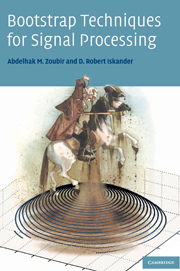1 - Introduction
Published online by Cambridge University Press: 03 December 2009
Summary
Signal processing has become a core discipline in engineering research and education. Many modern engineering problems rely on signal processing tools. This could be either for filtering the acquired measurements in order to extract and interpret information or for making a decision as to the presence or absence of a signal of interest. Generally speaking, statistical signal processing is the area of signal processing where mathematical statistics is used to solve signal processing problems. Nowadays, however, it is difficult to find an application of signal processing where tools from statistics are not used. A statistician would call the area of statistical signal processing time series analysis.
In most statistical signal processing applications where a certain parameter is of interest there is a need to provide a rigorous statistical performance analysis for parameter estimators. An example of this could be finding the accuracy of an estimator of the range of a flying aircraft in radar. These estimators are usually computed based on a finite number of measurements, also called a sample. Consider, for example, a typical radar scenario, in which we aim to ascertain whether the received signal contains information about a possible target or is merely interference. The decision in this case, based on calculating the so-called test statistic, has to be supported with statistical measures, namely the probability of detection and the probability of false alarm.
- Type
- Chapter
- Information
- Bootstrap Techniques for Signal Processing , pp. 1 - 10Publisher: Cambridge University PressPrint publication year: 2004
- 1
- Cited by



